Editor’s note: This article was originally published on May 6, 2020.
On Dec. 8, 2012, members of the U.S. Navy’s vaunted Naval Special Warfare Development Group, better known as SEAL Team 6, were deployed on an high-stakes nighttime raid with a simple goal: rescue a civilian doctor from the clutches of the Taliban.
As the rescue force, led by 28-year-old Chief Petty Officer Nicolas Checque, approached a building within the Taliban compound, a nearby sentry identified the approaching American commandos and darted inside, ostensibly to alert his fellow fighters to the coming assault. Realizing the Taliban guards knew they were there and would likely kill the hostage, Checque engaged the guard and sprinted through the door to face the enemy, according to military records. The mission was, in some way, a success: The hostage was rescued and flown to safety. But there were casualties—Checque was killed by the barrage of close-range fire.
Checque’s sacrifice isn’t just another story of courage and valor from the annals of U.S. military history: Just one year later, it would end up reigniting the U.S. military’s attempt to reimagine the warfighter of the future—one cloaked in the safety of a suit of robotic armor.
The military called this particular, Checque-inspired suit the Tactical Assault Light Operator Suit, or TALOS for short. To the press, it was known colloquially as the “Iron Man” suit. It was the hottest topic in defense circles—until, in 2019, the project was abruptly shut down.
The history of TALOS, along with the prototypes that came before it, reveals not just the military’s long-standing fascination with mechanized warfare, but also its inability to radically transform the standard tactical kit that’s been a staple of American troops for decades.
“The fact that personal protective equipment for operators has not significantly changed since WWII was certainly part of the impetus for SOCOM exploring how to provide operators with comprehensive ballistic protections,” Navy Lt. Cmdr. Tim Hawkins, a U.S. Special Operations Command spokesman. “Not only that, but we wanted to do so while enhancing their tactical capabilities and strategic effectiveness.”

From Talos to TALOS
Standard combat gear may not have changed much since World War II, but that doesn’t mean that TALOS didn’t have centuries of military imagination to draw on. According to Adrienne Mayor — a Stanford University historian and the author of Gods and Robots: Machines, Myths, and Ancient Dreams of Technology — the TALOS acronym is a tribute to Talos, the giant bronze android of Greek myth who patrolled the shores of the island of Crete in epic poems stretching back as far as Homer’s writings in 700 BC. “Exoskeletons and automatons for human enhancement have been in the human imagination for millenia, as far back as 2,700 years if you go back to the story of Talos,” Mayor said.
“The entire history of technology and war, whether it was the very first stone picked up that was more powerful than balling a fist to the first hobnail sandals that the Assyrians used to march further and faster, is always about enhancing human performance,” added Peter Singer, a fellow at the New America Foundation and author of the novel Ghost Fleet.

Though tales of augmented soldiers are found stretching back through centuries of Western literature, the modern idea of powered armor become a fixture of the military imagination when Robert Heinlein introduced the world to a quasi-fascist future of intergalactic warfare with 1959’s Starship Troopers, now a fixture of virtually every official U.S. military reading list. The opening pages of Heinlein’s classic present the future soldier as a one-man army, soaring above enemy forces jet-assisted leaps and bounds clad in an armored exoskeleton reminiscent of “a big steel gorilla, armed with gorilla-sized weapons.” Tanks and warships take unparalleled skill to pilot, Heinlein wrote, but the elegant allure of powered armor for the troops of the future is that “you don’t have to control the suit; you just wear it, like your clothes, like skin.”
Faster, stronger, more durable and more deadly, Heinlein’s vision of powered armor coincided with the growing engineering feasibility of incorporating robotics into modern combat. The Defense Department has been pursuing the dream of a powered exoskeleton since around the same time that Heinlein’s vision of future war introduced the concept to pop culture.
In 1961, just two years after the publication of Starship Troopers (and two years before Tony Stark’s Iron Man suit debuted in the pages of Marvel Comics), the Pentagon invited U.S. defense contractors to submit proposals for a “servo soldier” that was billed as “a human tank equipped with power steering and power brakes. The servo soldier “will wear a special suit which will have its own engine, enabling him to run faster, stop quicker, and lift bigger loads than ordinary mortals,” per Armor magazine. “What is more, he will be immune to germ warfare, poison gas and the heat and radiation from nuclear blasts.” It was the U.S. military’s first official vision for a robotic super-soldier wrapped in a cocoon of heavy armor, the groundwork for the decades of attempts that followed.
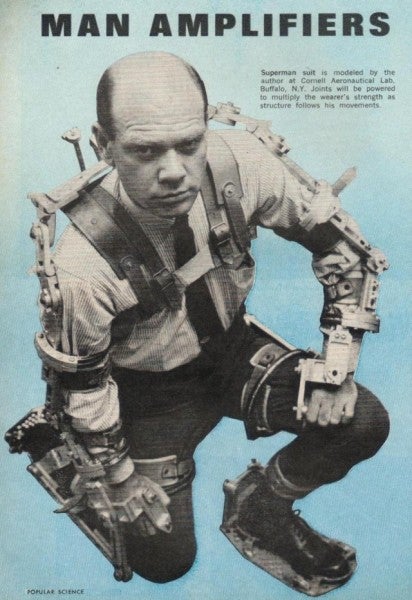
That same year, an Office of Naval Research grant enabled Cornell University engineer Neil Mizen to develop his so-called “Man Amplifier” exoskeleton. Built on a series of actuators manipulated through “bilateral force feedback,” according to Popular Science, Mizen’s suit — a skeletal, ungainly patchwork of bulky gray motors — could purportedly heft up to 1,000 pounds, making it ideal for handling heavy munitions and lugging cargo across inhospitable terrain. Indeed, the Navy in particular expressed interest in the “superman suit,” as Popular Science called it, “to help sailors manhandle torpedoes, bombs, and machinery in the cramped quarters aboard ships and submarines.”
Then, in 1965, a collaboration between Naval Air Systems Command, the Army Mobility Equipment Research and Development Center, and General Electric drew on Mizens’ research to develop a “man-augmentation” system, dubbed the Hardiman: a massive, hulking 30-joint exoskeletal system driven by hydromechanical servos in which man and machine “can be combined into an intimate, symbiotic unit that will perform essentially as one wedded system,” as GE project engineer Ralph S. Mosher wrote at the time.
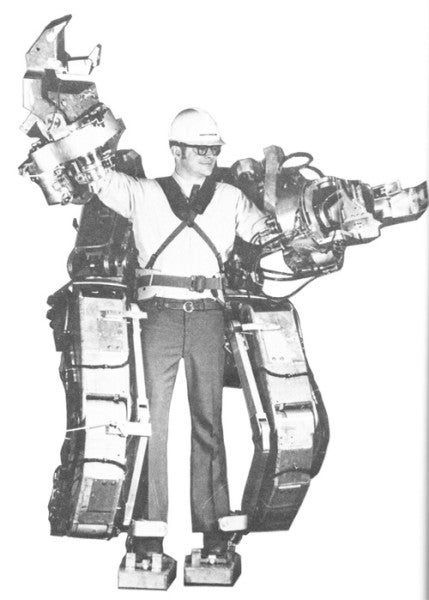
These two early suits were more equivalent to the power loader from Aliens than Iron Man’s slick combat armor, designed to help troops haul heavy loads over long distances. While GE unveiled the prototype in 1969, the Hardiman suit never came close to that “intimate, symbiotic” blend that Mosher envisioned: a 1971 report said the system could never advance above two miles an hour thanks to “violent and uncontrollable motion by the machine,” rendering the apparatus useless in any potential combat application.
The first true combat application of the powered armor concept appeared in the 1980s. Developed by Jeff Moore of the Los Alamos National Laboratory’s Advanced Weapons Technology Group, the “Pitman suit” cocooned the operator in 500 pounds of fiberglass and ceramic armor to provide “enhanced special forces capability for low intensity conflicts and counterterrorism,” the exact sort of door-kicking that would lead to Checque’s death decades later. Operated by brain patterns rather than a physical mechanism, the suit proved an engineering pipe dream, its core functions unattainable by the technology of the time.
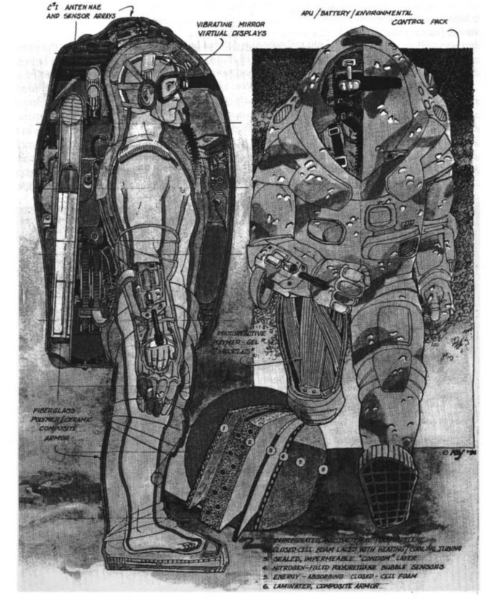
Indeed, the Pitman “suit of armor” exoskeleton concept proved so technologically unfeasible that it fell out of favor with military planners after the Army quickly stood up and abandoned yet another powered armor attempt at the Aberdeen Proving Ground in the early 1990s. It wouldn’t be until Checque’s death that the Pentagon returned to the idea of a combat-ready suit in earnest. (And if it seems like these projects are overlapping, that’s because they are: As the SOCOM spokesperson explained, “Someone comes along and picks up the research and adds to it and then it gets dropped for whatever reason until someone else comes along to pick it up.”)
Frustrated by the complexity of a full-body system, the Pentagon shifted its focus to a more stripped-down concept in the mid-1990s with its so-called Battle Dress System, an Army Special Operations Command-specific all-weather uniform that was designed to “accept the addition of emerging communications, sensor and weapons technologies.” More akin to bad weather coveralls than a suit of armor, Hawkins confirmed that the BDS was intended to function as a “stealth suit” with unique camouflage capabilities. Around the turn of the century, the Army incorporated its past lessons into the Future Force Warrior concept, a futuristic combat uniform more akin to something out of Demolition Man or Judge Dredd than a conventional personal protective system, but that system, though it yielded a handful of demonstrators in the early 2000s as part of the Army’s Future Combat System modernization program, never matured into a kit effective enough for fielding.
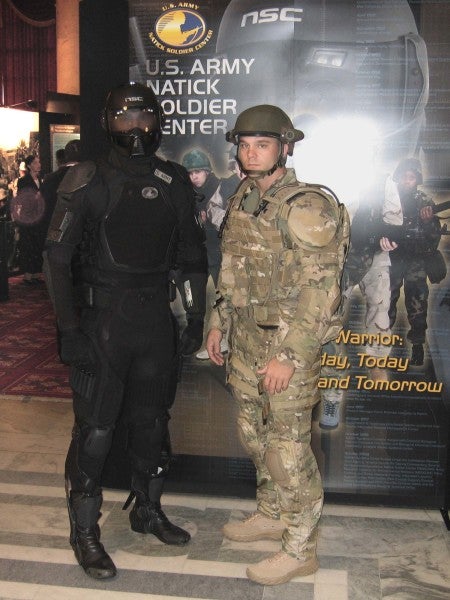
This stripped-down approach persisted well into the 2000s, when the sudden technological feasibility of powered exoskeletons induced the Pentagon to pivot back to its pursuit of Tony Stark technologies that were more focused on logistics, rather than combat. In 2001, the Defense Advanced Research Projects Agency (DARPA), yet another military tech incubator, awarded two $50 million grants for the development of exoskeleton prototypes: one to Lockheed Martin, and another to Raytheon. Both projects consisted of exoskeletons focused on reducing strain on the lower legs and back. Though both failed at developing versions of the technology that were ready for the field, they established that robotics had finally advanced to a point where exoskeletons could actually enhance the movement of future soldiers. Indeed, exoskeletons, the core of any futuristic powered armor, had suddenly entered the realm of the possible, though the focus had again shifted back to logistics.
“The weaponized, sci-fi-sexy version is always going to get more attention, but the logistics side has always had an actual commercial equivalent driving it forward,” said Ghost Fleet author Singer. “There’s always been that R&D work related to the construction field and other private-sector projects, and that’s what we’re still drawing on. We’ll end up seeing this in non-combat applications first.”
With U.S. troops now regularly hauling upwards of 100 pounds of gear into combat, a robotic assist to the legs is a welcome change — though none of these exoskeletons on their own would make much of a difference to commandos like Checque who are first through the door during a firefight. Luckily, these efforts weren’t for nothing: According to Hawkins, DARPA provided researchers with details on past exoskeleton efforts to better inform the TALOS’ construction. Even better, SOCOM also spent a year conducting market research not just among the defense industry, but “non-traditional” partners like research universities while developing a clear operational concept for the project.
Imagining the ‘Iron Man suit’
[embedded content]
SOCOM first announced the TALOS suit in 2013 with an ambitious vision for the final product depicted in a corny promotional video: an armor-plated soldier capable of withstanding direct fire from small arms like those that killed Checque in Afghanistan. But when Army Lt. Col. Alex MacCalman revealed the results of the five-year effort at the Special Operations Forces Industry Conference in Tampa, Florida in May 2019, the final product was anything but.
MacCalman was the ideal man for the job. MacCalman had spent two years on U.S. Special Operations Command’s TALOS task force, first as the chief engineer and then as program director. A former 7th Special Forces Group deployed analyst, MacCalman was in Afghanistan with the Army’s elite Delta Force in 2012 when Checque burst through the door of that Taliban compound. (Hawkins, the SOCOM spokesman, confirmed that Checque’s death was the direct inspiration for the TALOS program. MacCalman declined to comment for this story).
SOCOM had a laundry list of capabilities in mind: increased survivability through enhanced ballistic protection and an exoskeleton that “supports near unconstrained movement” while managing heavy loads, a “base layer” with integrated biomedical monitoring and thermoregulation, a heads-up display that integrated intelligence and operational data, and a boost in “surgical lethality” that involved creating “options for novel weapons integration.”
The final product would be a vision from the future, at least according to early designs included in MacCalman’s presentation in Tampa: a robotically-muscled warfighter clad in a suit of armor, like something from a recent installment of the Halo franchise.
The engineering results of the five-year TALOS effort came closer to producing a suit of armor than any previous attempt in Pentagon history. The program had yielded roughly 10 “mature” subsystems: among them, advanced new body armor, an augmented reality heads-up display, and a lower-body exoskeleton that was designed to significantly reduce wear and tear on the legs and back. The result was, by most measures, a revolutionary step above standard-issue body armor.
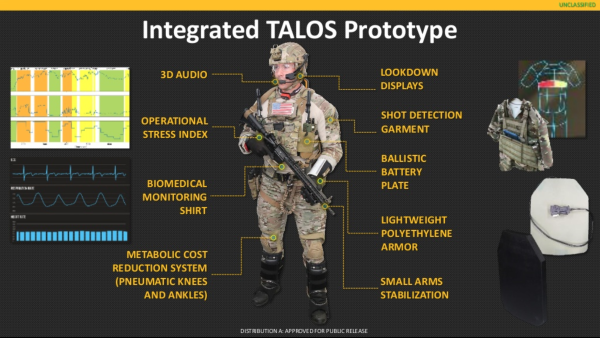
But even with 50 years of research and the might of the U.S. military-industrial complex behind it, the JATF-TALOS program fell short of its goal of true futuristic glory ripped from Heinlein’s pages. Though the program yielded a slew of advanced systems, the Pentagon’s latest stab at a suit of unified powered armor ended up essentially dead in the water. In February 2019, a spokesman for the program confirmed that SOCOM had “no intent to field the TALOS Mk 5 combat suit prototype” beyond a mere demonstration. By May, MacCalman was delivering that super-suit’s eulogy to a crowded room at the Special Operations Forces Industry Conference in Tampa.
With the program disbanded, people like MacCalman moved on to work in other armed forces acquisition programs. According to Hawkins, the suit itself is now quite literally collecting dust in a box somewhere.
According to SOCOM, the ghosts of past exoskeletons underpin the end of the TALOS program. The fatal flaw of the combat prototype, as SOCOM spokesman Hawkins explained, lies in the suit’s “complex subsystem interdependencies” — the inability for the subsystems from the exoskeleton to the suit’s helmet assembly, power and communications to operate together as a cohesive whole. There’s a level of choreographed interconnectivity that comes with overlaying so many complex systems on top of one another, and these individual systems must operate together seamlessly for the suit to actually achieve that man-machine fusion that Heinlein envisioned nearly a half-century ago. Even with advances in computing and miniaturization, there were too many disparate parts for TALOS to function effectively.
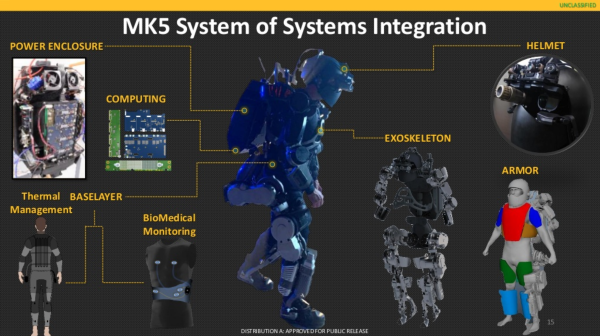
That’s not to say the suit was a total failure: As Hawkins told me, the program the mature subsystems yielded by JATF-TALOS will almost certainly see potential adoption elsewhere in the U.S. military. Indeed, the body armor in particular is among its most promising mature subsystems: made from ultra-high-molecular-weight polyethylene — a substance lighter but more durable than standard armor plates — it’s currently undergoing field testing by active-duty SOF units, which means better protection for door-kickers like Checque, just as the TALOS program intended in the first place. The unified ‘Iron Man’ suit may be dead, but its spare parts will likely live on in other Pentagon programs of record — and, if fully matured in the coming years, end up actually achieving the TALOS program’s original goal of better survivability, albeit in a different form.
The end of the TALOS program doesn’t mean that the Pentagon has permanently abandoned some sort of exoskeleton for infantry troops. Lockheed Martin’s new exoskeleton, currently the apple of the Army’s eye, is essentially a robotic, motorized knee brace designed to lessen fatigue on hostile terrain; and the Marine Corps is on the verge of testing out a full-body exoskeleton that could haul pallets full of gear so the average grunt doesn’t blow out his back doing the task.
More importantly, just as the Hardiman, Man Amplifier, and the Pitman suit helped inform TALOS, so might SOCOM’s supersuit one day inform yet another attempt at powered combat armor. As Hawkins put it, the research is “laying around” for Pentagon engineers to examine at any time. And that day could come sooner than you think: As Singer pointed out, China is currently testing a powered exoskeleton designed to help infantry members carry roughly 100 pounds of gear with ease, and with the Pentagon hyping a pivot to “great power competition,” military planners have an incentive to track Beijing’s progress and adapt accordingly.
After more than 50 years of research, the Pentagon’s vision of a machine-powered “servo soldier” remains no closer to becoming a reality than it once was. But as TALOS goes to show, the dream of powered combat armor persists in wayward laboratories and annexes of the U.S. military — and while the vaunted combat suit may be hidden away in storage somewhere, it lies in wait for the next innovative researcher to take a stab at making the Pentagon’s vision of a mechanized super soldier a reality.

